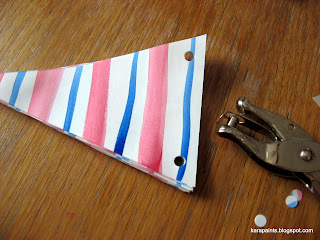Because nothing says "Happy Birthday, America!" like tri-color bunting.
I've kept the pattern generic enough that you can use it for Memorial Day, Veteran's Day, Bastille Day and your 17th May celebrations. I'm sure that there are other countries who use a Red-White-Blue color scheme as well, so feel free to get festive in a global manner.
Let's get Crafty.
Gather your supplies!
Two sheets of 11"x14" paper
Ruler--I like an 18" ruler, myself. (Insert bad George III pun here)
Pencil
Scissors
Watercolor brushes--one large, one small
Kitchen string--usually for trussing roast birds, but I find it to be an invaluable addition to the art cupboard.
Watercolor paint
On the long edge of your paper, mark at 3.5", 7", and 10.5".
Do this on the top & bottom edge
Step two: Connect the dots!
La la la, connect the dots!
From the top left corner to the bottom 3.5" mark.
From the top 3.5" mark to the bottom 7" mark.
From the top 7" mark to the bottom 10.5" mark
From the top 10.5" mark to the bottom right corner.
It's diagonal, baby!
Step three: Reverse!
Connect the dots:
From the top right corner to the bottom 10.5" mark
From the top 10.5" mark to the bottom 7" mark
And so on and so forth. When you're done, it should be a lovely diamond pattern, like the above picture.
Step four: Draw a line that bisects your diamonds & turns them into triangles. This should be about 5.5" up the page.
Next: BRING OUT YOUR PAINT!
Step five: On one sheet, free-hand horizontal lines in red with your big brush. On the second sheet, free hand vertical lines.
No, seriously. Free-hand them. You're making a bunting that is unique to you, not machine made! Also, the squiggles aren't obvious once you cut out your triangles.
Let your red paint dry.
Step six: On your horizontal-line sheet, free hand a blue line with your small brush in the white space.On your vertical-line sheet, use your small brush to make polka-dots down the page in the white spaces. Let your paint dry completely.
Step seven: Cut out your triangles--follow the lines you drew before the painting happened.
Step eight: Stack your triangles 4 deep, and pop holes in the top with your hole punch. Make sure your holes are at least 1/3" from the edge to prevent tearing while you string them up.
Step nine: Thread those bad boys up. I went with a simple A-B pattern, but if you're working with kids have them pattern it however they want. Below is an overhead shot of the threading technique.
Taa-daah!
I cut 7.5 feet of string, and it I had 5 flags left over. You could cut 9 feet and use them all.Tie a loop at the end of the string. This way you can hang it on a nail, or hang it using tape. Also, it keeps your flags on the string while you carry it around the house.
And if you have a few triangles left over, you can pull out some skewers and make flags!
Now even your potted plants can feel the festive air! (Or you could stick them in a cake, a flower arrangement, a toy boat, or your hair)
Happy Independence Day, y'all!


































